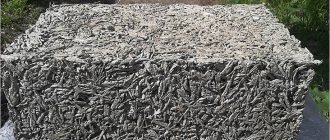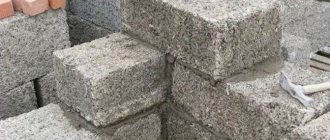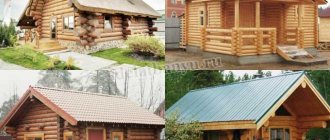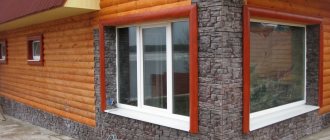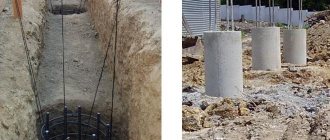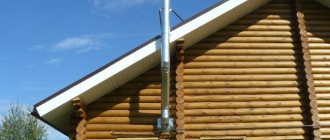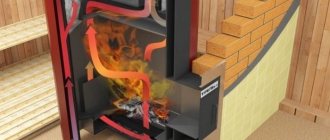Private developers often try to speed up the construction of buildings on their sites, so they often use unconventional construction technologies. One of them includes a foundation made of barrels, which involves a formless version of the foundation for the structure. The result is point supports - buried or installed on sand pads directly on the ground surface. This method has many fans and opponents, each of which has its own arguments and assumptions. But the fact remains that a method of constructing a foundation from concrete-filled barrels exists, although it has some limitations.
Prepare the solution and fill the foundation with your own hands
What craftsmen can come up with to save on construction and reduce the amount of work performed.
It’s hard to imagine that any farmer in Iowa would have the crazy idea to put a house on tractor tires or make a well out of them. We don’t have any problems with this - quite often homemade people invent such “bicycles”, and then go to the forums to ask why their foundation is skewed, the wall is cracked, how to fix everything and what to do. The same applies to various “unusual” types of foundations, information about which, thanks to the Internet, quickly spreads among amateur builders who are trying to implement these ideas on their suburban sites, relying only on rumors and very fragmentary information from the field of construction. For example, you can increasingly hear about foundations made from 200-liter barrels. But will such a foundation be a reliable support? And is it worth spending effort on setting up such a foundation? How do you know if it will freeze or sag? And what does this depend on? Let's try to figure out whether it is worth spending effort on building a foundation from 200-liter metal barrels and see in which cases it is better to immediately abandon this idea.
Preparation of the solution
Material selection
The preparation of concrete must be approached with particular responsibility, since the reliability of the entire structure will depend on this. The composition of the solution and its brand depend on the type of structure. For example, for small structures made of lightweight materials, lightweight concrete can be used, which will save money and at the same time make the structure warmer.
However, not all materials are suitable even for light structures; for example, it is impossible to build a foundation from foam concrete due to its low strength and hygroscopicity. Such material will absorb moisture and simply crack when frozen.
Also, you should not try to make a foundation from polystyrene concrete, since its strength will also not be enough, however, this material can be used to build a base. This option is especially common when building houses from aerated concrete.
But a foundation made of expanded clay concrete for light construction is quite acceptable, since expanded clay itself is a fairly durable material. When the temperature changes, expanded clay concrete does not expand or contract, which ensures a constant shape. In addition, expanded clay concrete has good wear resistance.
But, of course, the most durable is traditional concrete, which can be used for any buildings made of any materials. The only thing is that it must be prepared correctly, since all the basic characteristics of concrete depend on this. Therefore, we will consider this process in more detail.
Preparation of concrete
To prepare concrete you will need the following materials:
| Cement | Most often, cement of the M400 or M500 grade is used for the construction of a concrete foundation. Of course, the price of M500 is slightly higher, but such cement allows you to create more durable concrete. |
| Sand | Purified sand should be used to build the foundation. The fraction sizes should be in the range of 1.2-3.5 mm. |
| Crushed stone | Large filler must also be cleaned of clay or other contaminants. The particle size of crushed stone or gravel should be within 1-8 cm. |
| Water | Like all other ingredients, the water must be clean. |
The most optimal concrete for the foundation is M350. To obtain it, components are used in the following proportions:
| Cement grade M500 | One part |
| Sand | Two parts |
| Crushed stone or gravel | 4 parts |
| Water | ½ part |
The instructions look like this:
- First of all, you need to mix the dry ingredients - cement and sand..
- Then water is added to the composition and the solution is thoroughly mixed . You can also add a plasticizer to improve the characteristics of the material or other additives as necessary.
- After obtaining a homogeneous solution, crushed stone, previously moistened with water, is added to it and mixed thoroughly.
This completes the concrete making process. It must be said that sometimes a foundation is built from sand concrete. In this case, crushed stone is not added to the composition. Ready-made dry sand concrete mixture can be purchased at construction stores.
Barrel foundation design
In general, the design of a foundation made of metal barrels is not much different from any other columnar foundation - barrels are installed at the corners of the building being erected and at certain intervals under the walls, into which broken bricks are poured or reinforcement is installed, depending on the design of the piping. After which the barrel is filled with concrete.
If you plan to install a grillage, then you should provide outlets for fittings that will allow you to reliably connect the grillage to the barrel. If the logs or beams of the lower crown simply rest on the barrel, then you can do without reinforcement.
The support area of each barrel is quite large compared to foundations made of asbestos cement pipes. Therefore, such a foundation is quite capable of supporting a small house. However, several important conditions must be met. What are these conditions, read below.
Positive and negative sides of the “barrel” foundation
One of the advantages of the technology of constructing a foundation from metal barrels filled with concrete is the needlessness of constructing formwork. Firstly, this significantly saves time, and secondly, it does not require special qualifications of workers. But, unfortunately, there are many more disadvantages to this type of work. In particular, they relate to the effectiveness of the method used.
Few households have the number of 200-liter or other metal barrels needed to construct a foundation, so they will have to be purchased. Such a purchase can be much more expensive than the cost of boards, fasteners and other materials necessary for installing the formwork. Also, in most cases, it is irrational to overuse concrete when filling the required volume of metal shells, especially in the case when it is necessary to deepen the foundation by more than a meter due to the low freezing horizon of the soil. In this case, you will have to install not one, but two barrels in height. Although, under small structures with deep groundwater, it is often practiced to install a sand cushion instead of additional deepening, and on rocky soils the barrels are left directly on the surface.
Difficult clay soils and high groundwater levels require laying the foundation below the freezing level, otherwise the swelling forces may be higher than the foundation pressure, which will lead to the lifting of the barrels and distortion of the structure.
It is also necessary to understand that moisture-saturated soils after thawing often cause changes in the location and subsidence of metal foundation pillars if the deepening, backfilling or sand cushion was carried out incorrectly.
Features of the construction of a slab foundation
The use of barrels filled with concrete is not yet so widespread today, which cannot be said about a slab foundation. This decision justifies itself if the land on the construction site is not in the best condition. Carrying out this type of work does not involve very large labor costs.
The most optimal option is a base with ribs, since it has an impressive margin of safety.
Video on how to make a foundation for a bathhouse from scratch step by step
The quality of the foundation largely determines the service life and characteristics of the structure being built. A minor violation of technology can create serious difficulties not only at the construction stage, but also in the subsequent operation of the bathhouse. Watch the video, which explains in detail how to make a foundation correctly.
Currently, various building materials are available that allow you to build a foundation for a bathhouse in different ways. Choose the appropriate option, and then you will have a comfortable place where you can wash and have a good rest.
Freezing depth
The most important factors when building a foundation are the depth of soil freezing and the composition of this same soil at the construction site. And that's why. Clay soils have the unpleasant property of greatly increasing in volume as a result of freezing. The moisture in such soils freezes, and when water freezes, as is known, its volume increases. As a result, the soil begins to heave and all these movements are transferred directly to the building.
IMPORTANT! When heaving soil freezes, it can increase in volume by up to 10%!
Therefore, when building on such soils, the base of the foundation is buried below the freezing mark so that the foundation rests on a reliable foundation, which lies quite deep and does not freeze in winter. If this is not taken into account, the result of construction will be cracked walls, destruction of structures and the need for labor-intensive repairs of the entire structure. The heaving of soils can be determined based on an independent study of soils on the site and the presence of moisture at different times of the year. So, for example, if the groundwater level rises only in the spring, this is not so scary, since it will not lead to freezing of the foundation. Typically, in such areas, puddles and mud appear only during the spring snowmelt. If throughout the year the soil on the site has fairly high humidity, then this is a bad sign. In addition, you should pay attention to the composition of the soil, which can be visually determined by the twisting of a ring from a small piece of soil, from which they roll a “sausage” and then try to bend a ring out of it. Clay and loamy soils roll easily and bend into a ring almost without breaking up. It will not be possible to roll sandy soil - it will crumble into grains of sand. Having determined the composition of the soil, a decision is made on the depth of the foundation base. Since the height of the barrel is 85 cm, lowering such a foundation below the freezing depth will only work in the southern regions, where in winter the soil practically does not freeze or freezes to a shallow depth. In other cases, it is better to place a house or bathhouse on screw piles or on a foundation using TISE technology. But is everything really that bad and a foundation made of barrels is a fool’s errand? Of course, in some cases such a support will be a fairly reliable basis, and in which cases, read below.
Dependence of the choice of foundation on soil characteristics and groundwater characteristics
Let's consider the possibility of building a foundation from pipes. It should be borne in mind that this is by no means a universal foundation (excluding pile foundation with screw piles). In the case of complex soils and a large weight of the building, such a foundation will not be suitable; it is necessary to build more complex varieties - monolithic slab, monolithic strip, strip of blocks, monolithic pile.
Therefore, in order to have absolute confidence in the correct choice of pipe foundation, you need to order a geodetic survey of your site. It will include a conclusion about the soils, their layered arrangement, the depth of groundwater, the depth of soil freezing and the presence of water “lenses” inside the soil.
Geodetic research must certainly precede the design of the future structure and accompany it as it progresses
The classification of soils is presented in reference books; for example, in the textbook “Soils. Foundations. Soil characteristics. Choosing the optimal foundation":
- Rocky soils are, rather, crystalline rock, rock rather than earth, and sedimentary rock (dolomite, compressed sandstone, shale, shell rock, limestone). Any foundation is acceptable except a pile foundation (it is difficult to drill into rock).
- Conglomerates are fragments of varieties of rocky soils; do not erode or change in volume when freezing; Any foundation is acceptable.
- Non-rocky soils:
- bound - clayey and loamy; freeze deeply; capable of “floating” and moving, only heavy types of foundations are suitable;
- unbound - sandy and sandy loam soils; when wet they tend to move and freeze shallowly; Any type of foundation is suitable.
Different soils that may be found on your site
Knowing this list, you can approximately determine the type of your soil yourself: drill a hole with a garden drill and study soil samples from different depths.
As a result of geodetic work, you will receive complete information about the condition of your site
If a soil sample moistened with water can be kneaded like dough, then your soil is loam. If the earth dissolves in water, it contains a large percentage of loamy component. If sediment falls, there will be clay at the bottom and sand above it.
To determine the type of soil, you need to place the sample in a glass of water
If you have good, stable soil on your site - a mass of rock, untouched sandstone, or sedimentary rocks, or sand, or dense loamy soils, then a foundation made of pipes is quite suitable for any light building such as a frame house, veranda, gazebo, barn. A foundation made of screw piles is suitable for any construction on any soil.
The freezing depth in central Russia is about one meter, but deviations are possible. The lowest point of the base of any buried foundation must be below the freezing point of the soil. This most often does not apply to pipes (except for screw piles).
Freezing depth is a factor influencing the foundation depth
This is the most important characteristic of soils, and the required type of foundation also directly depends on it.
The groundwater level at the site has a huge influence on the choice of foundation type
Pipe foundations (excluding screw pile foundations) are applicable only when the groundwater level is low. If this level is high, then other types of foundations need to be considered. However, it is important to take into account the water level indicator along with the freezing depth. If the water in the cold season is located at a depth below two meters relative to the freezing point of the soil (the freezing depth can be designated as Z), and the soil is quite dense (clay, sand), then the freezing depth can be ignored.
Features of construction work
Private developers often try to speed up the construction of buildings on their sites, so they often use unconventional construction technologies.
One of them is a foundation made of barrels, which involves a formless version of constructing a foundation for a structure. This method has many fans and opponents, each of which has its own arguments and assumptions. But the fact remains that a method of constructing a foundation from concrete-filled barrels exists, although it has some limitations.
The top of the barrel must be removed. The removable lid is simply removed, and the circle is completely cut off from the closed container. You can leave the bottom of the barrel; there is no need to get rid of it.
The prepared casings are installed on a prepared, leveled base at the corners of the building, at the junction of load-bearing walls, and, if necessary, in the spaces between already installed foundation supports. First, markings are made by pulling cords around the perimeter of the structure. They will serve as a guide for correctly determining the location of the barrels in the plan. Separately, under each container, a small pit is dug to the depth of the underground structure, to the bottom of which, in stages:
- a leveling sand cushion 10-15 cm thick is added;
- roofing felt is laid in 1-2 layers as waterproofing;
- metal shells lubricated with waste oil are installed.
Features of folk technology
To construct the foundation, metal barrels are used with the lid cut off, and often the bottom, resulting in a kind of formwork in the form of a cylindrical casing-shell. Standard products have:
- volume – 200 liters;
- diameter – 60cm;
- height – 85cm;
- wall thickness is about 1mm.
Prepared barrels are installed at the corners of the structure and in the spaces between them, which depends on the size of the structure in plan. Based on the type of soil and its freezing mark, the foundation is buried 30-50 cm or more, or left on the surface of the earth, after which the metal casings are filled with concrete. If necessary, reinforcing mesh is placed in the barrels in advance to simplify the adhesion of the pillars to the grillage. The result is a simple DIY foundation that can support small structures:
- country house;
- summer kitchen;
- winter gazebos;
- baths, etc.
Features of pouring a foundation from barrels
Concrete can only be poured into barrels whose lids have been removed. If you have to work with a welded barrel, then you can get rid of the lid by cutting. The shell must be mounted at the site of the building's support; in the future it will act as formwork. You will need approximately 4 or more similar support points.
Table of components for making concrete mixture.
After the concrete for pouring the foundation is ready, it can be poured into the shells. Reinforcement can be done with steel rods. Waterproofing must be laid in two layers on the surface of the barrels. It is preferable to use roofing material for this.
Ultimately, it will be possible to obtain point supports on which the lower crown of the walls will be mounted. It is permissible to bury the shells into the soil up to the freezing line. Whereas, if the installation is carried out without deepening, a compensation cushion should be installed under them; the thickness of the sand layer should be 10 cm or more.
Table for determining the grade of concrete based on its strength.
Work must begin with marking and leveling the soil on the site. Markings should be made using the method of pulling cords, after which the location of the barrels should be marked. They should be lubricated with used oil before installation.
Blind area
The most important structural element of any building and ancillary building is the blind area. Its functions include protecting the foundation from erosion during rain, melting snow or floods. A waterproof coating is placed around the perimeter of the entire structure with a slope directed from the base. The width and slope of the blind area depends on several factors, among which the most important are:
- soil type;
- removal of roof eaves.
First of all, the future contours of the blind area are outlined locally - both external and internal. The first, as a rule, runs at a distance of 0.9-1 meter from the outer surface of the barrels, and the second - along their central axis. It should be noted that the outer line may be located somewhat closer to the tanks, depending on the ground conditions and the overall design of the building. Within the intended boundaries, a layer of earth approximately equal to the size of a shovel is selected, and an edged board is laid on both sides as formwork. A 10-centimeter layer of sand is poured into the resulting recess, which is compacted after moistening. Next, lay out a 2-3 cm layer of crushed stone and compact it as well.
Perpendicular to the blind area, every 1.8-2 meters along the length, thin wooden slats are placed edgewise, which are necessary for organizing expansion joints. They protect the concrete screed from destruction in the event of temperature changes or soil subsidence.
The final stage will be laying a concrete layer approximately 4-5 cm thick, leveling and forming a slope away from the building. Subsequently, ironing is carried out or the finished surface is impregnated with polymer compounds that prevent the formation of microcracks on the screed or any other defects that allow moisture to penetrate into the concrete layer. It should be noted that the screed can additionally be finished with tiles or stone, but this depends on the taste of the owner.
Features of the construction of a slab foundation
The use of barrels filled with concrete is not yet so widespread today, which cannot be said about a slab foundation. This decision justifies itself if the land on the construction site is not in the best condition. Carrying out this type of work does not involve very large labor costs.
Before starting work, you will have to choose one of the slab bases; it can be a regular concrete-based pad or a base that has stiffeners.
The most optimal option is a base with ribs, since it has an impressive margin of safety.
Selecting a concrete strength grade for pouring (concreting) the foundation of a private house
To fill the foundation of a private house, a concrete solution of at least grade M200 is used (see the article “types of concrete”), and when building stone or block buildings, grade M250-M300 is used. However, when using these grades for the foundation, waterproofing is necessary because these types of concrete solutions are not waterproof.
Many experts recommend immediately using special hydraulic concrete mixtures of grades M400 and higher. However, there may be dangers here: it is very difficult for a non-specialist to determine the brand of concrete by sight, and they can bring you anything, so first of all, upon delivery, ask for a certificate confirming the authenticity of the concrete brand and its compliance with TU and GOST.
The poor quality of the concrete mixture can be determined only after 28 days, when obvious defects appear on the hardened foundation, however, the quality of fresh concrete can be determined by appearance.
An obvious defect is the consistency of the solution, that is, the ratio of cement and filler: the formation of voids during pouring, which must be filled with dry filler, indicates poor quality of the concrete mixture.
Crushed stone husks are also considered defective: when mixed in a mixer, crushed stone peels off - this is a defect. Suppliers may try to explain to you that this is an intended screening, but it is not included in the formulation of medium fraction concrete.
Of course, it is necessary to check the delivered concrete mixture for radioactivity. According to the first class of radioactivity, the solution should not exceed 370 bq/kg; higher values mean that the unscrupulous supplier contains crushed stone in the concrete that is not intended for residential construction; such crushed stone can only be used for railway construction.
Keep in mind that standard background radiation dosimeters have readings in microroentgen/hour, and not in bq/kg, so you need to prepare in advance and be able to translate the readings.
Stages of work
The top of the barrel must be removed. The removable lid is simply removed, and the circle is completely cut off from the closed container. You can leave the bottom of the barrel; there is no need to get rid of it. The prepared casings are installed on a prepared, leveled base at the corners of the building, at the junction of load-bearing walls, and, if necessary, in the spaces between already installed foundation supports.
First, markings are made by stretching cords around the perimeter of the structure. They will serve as a guide for correctly determining the location of the barrels in the plan. Separately, under each container, a small pit is dug to the depth of the underground structure, to the bottom of which, in stages:
- a leveling sand cushion 10-15 cm thick is added;
- roofing felt is laid in 1-2 layers as waterproofing;
- metal shells lubricated with waste oil are installed.
After backfilling the pits with a sand mixture with layer-by-layer wetting and compaction, they begin to fill the containers with concrete. The reinforcing mesh provided in the design is laid and fixed in metal shells in advance. Each barrel should be filled with the solution at a time, otherwise uneven setting can lead to delamination of the concrete monolith, which is unacceptable. Work on pouring the foundation is most often done manually, since concrete pumps are quite rare in private farms, and installing special gutters is not always a rational solution.
Experts recommend organizing the construction process in such a way that the “barrel” foundation does not remain unloaded during the winter period. Otherwise, after the soil thaws, there will be a possibility that the position of the filled containers will change.
Waterproofing is laid on top of the concrete barrels, protecting the walls from moisture penetration into the ground part of the building. For this, traditional roofing felt laid in two layers is most often used. The finished foundation is tied with a reinforced concrete grillage or a frame crown, if we are talking about building a bathhouse from a log house, for example.
What to consider and what is the calculation?
When determining the required amount of concrete for different foundations, take into account:
- type of soil and its freezing;
- number of storeys, dimensions and other features of the structure;
- correction factors for formwork expansion and shrinkage, equal to 1.1-1.3.
The ratio of components per cube of finished material is often used.
Usually the measure is 10 liters and all calculations are reduced to this volume. In private construction, calculations are carried out in buckets. It is considered classic to prepare a batch and calculate the volume of concrete per 1m3 in the following proportions: 2/9/5, where 2 is cement, 9 is crushed stone, 5 is sand. The recipe for making the mixture includes water, the amount of which is equal to half the cement. It is recommended to mix concrete for the foundation in a private building, grade M200. A solution of these components is suitable to properly make the foundation for a low house with your own hands.
Concrete grades for foundations
After determining the type of foundation and manufacturing method, you should accurately determine the type of mixture required. Depending on the purpose, the following grades of concrete are distinguished, as shown in the table:
| Brand | Application |
| M100 | Non-permanent buildings, sheds, floors, fences |
| M150 | Preparatory construction work, garage foundations |
| M200 | Foundation for frame-panel buildings |
| M250 | Suitable for construction no higher than 3 floors |
| M300 | Foundation for a house up to 5 tiers |
| M350 | The basis of brick high-rise buildings |
| M400 | Can be used for the construction of buildings with up to 20 storeys. |
Preparation of cement for the base
To mix the composition for a strip foundation, you should know how much of certain ingredients is required. It is also worth considering what proportion they are in. The composition of concrete for the foundation includes: cement, sand, crushed stone, water. It is not recommended to use concrete without crushed stone. This is how the strength of the foundation is lost. In standard buildings, the M200 or M300 brand is used. The water-cement ratio of the concrete mixture in all brands is equal to 0.5 to 1. That is, 1 kg of cement requires 0.5 liters of water. According to GOST, to mix M200 concrete, you need to take the following components (in parts):
- gravels - 4.8;
- sand - 2.8;
- cement - 1;
- water - 20% of the total volume.
The example in the table shows how many and what concrete components are required when mixing to obtain the required amount of working mixture:
| Concrete grade | Proportions of cement: sand: crushed stone | What is the yield for 10 liters of cement? |
| Cement M400 | ||
| 200 | 1:2,8:4,8 | 54 |
| 250 | 1:2,1:3,9 | 43 |
| 300 | 1:1,9:3,7 | 41 |
| 400 | 1:1,2:2,7 | 31 |
| Cement M500 | ||
| 200 | 1:3,5:5,6 | 62 |
| 300 | 1:2,4:4,3 | 47 |
| 400 | 1:1,6:3,2 | 36 |
Foundation made of barrels filled with concrete
- The need for a foundation
- DIY barrel foundation - pros and cons, features and stages of work
- Types of pipe foundations
- Choosing a house model
- Features of the construction of a slab foundation
- Dependence of the choice of foundation on soil characteristics and groundwater characteristics
- DIY barrel foundation - pros and cons, features and stages of work
Site preparation.
First, the site is cleared of construction debris. Next, make the markings.
To do this you need to take:
- Reinforcement or pegs;
- Rope;
- Roulette;
- Square with right angle;
- Level and clothespins.
You need to hammer in a peg and measure the length of one wall. Secure with a second peg. Then pull the rope for the perpendicular walls. Angles are checked.
Everything is fixed with clothespins. Then measure the distance between the diagonals.
The pegs must be driven in firmly and the rope must be pulled tightly. The result is a rectangle, the diagonals of which should be equal. Deviations cannot be more than 2 cm.
Procedure for working with a barrel
Foundation laying diagram.
If the barrels are equipped with removable lids, they are removed. For welded barrels, the lid must be cut off in any way. The bottom can also be removed, but this is not necessary. The resulting shell is installed in place of the support of a bathhouse, house or other building. In the future, it will serve as formwork. At least 4 such support points are needed. With a significant size of the planned structure, the number of support points can be several dozen.
The shells, which act as formwork, are filled with ready-mixed concrete. If desired, it is reinforced with metal rods. A double layer of waterproofing is laid on the upper surface of concrete-filled barrels. It is best to use rolled roofing felt for this purpose. This is done in order to properly isolate the foundation from the walls and prevent the possibility of soil moisture penetrating into the wall material.
ABOUT ME
I am a builder with over 20 years of experience and have done foundations in many different ways. Now I live in a village where I have my own small farm with chickens and fish in my own pond.
I’m resting, although not - I’m writing articles for you, and this is also work. By the way, you can find me in
Youtube
or write
I've probably thought about building a house inexpensively, but this foundation is inexpensive and durable. The houses stood for more than 10 years and no questions arose.
Everyone just shows how to build, but not everyone can show their work in 10-30 years. For your attention, I am exactly that person..))
Technology of pouring a monolithic slab
Scheme of a monolithic foundation.
Pouring the foundation with a concrete mixer will resolve the issue of the need to complete the work in one go in order to achieve solidity. The structure must have continuous reinforcement, which will guarantee strength characteristics. The slab can be given a thickness that will depend on the type of construction; this limit can be 200-600 mm.
Initially, it is necessary to determine differences in surface level in order to get rid of protruding areas.
Crushed stone and sand will act as a cushion. Next comes the installation of waterproofing and formwork elements. The structure should have a double frame made of reinforcement, and the wire will act as a ligament. The foundation is now being poured with concrete. The base must be leveled, covered with film and left for 4 weeks. During the first six days, the foundation must be moistened with water.
Fractions of crushed stone: 1 - crushed stone 5-20 mm, 2 - crushed stone 20-40 mm, 3 - crushed stone 25-60 mm, 4 - crushed stone 40-70 mm.
In order to ensure a warm climate inside the house, the foundation needs to be insulated. You can place the material under the slab. However, the most suitable option is insulation of finished floors. But if it was decided to thermally insulate the slabs, then polystyrene foam should be used; a layer of 100 mm will be sufficient.
To carry out the process you need to prepare:
